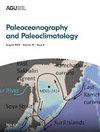利用高斯过程重建新生代δ11Bsw
IF 3.2
2区 地球科学
Q2 GEOSCIENCES, MULTIDISCIPLINARY
引用次数: 0
摘要
海水的硼同位素比值(δ11Bsw)是根据海洋碳酸盐的硼同位素测量值重建古pH值和二氧化碳时必须知道的参数。在几百万年前,δ11Bsw 很可能与现代不同。通过同时限制有孔虫δ11B(Δδ11B)和 pH 值(ΔpH)的垂直梯度,可以估算古δ11Bsw。过去曾使用过多种微妙不同的技术来估算 ΔpH,这些技术都大致基于对氧、和/或碳的垂直梯度或其他碳酸盐系统约束条件的假设。在这项工作中,我们汇集了以往研究中的现有数据,并通过建模对δ11Bsw 的变化率进行了限制。我们将这些信息整合到一个名为高斯过程的总体统计框架中。高斯过程技术使我们能够将数据与 δ11Bsw 变化率的约束条件结合起来,生成 δ11Bsw 的随机可信演变。我们利用这种新方法重建了过去 6500 万年的 δ11Bsw,并由此重建了古酸碱度。我们将重建的δ11Bsw与其他海水同位素比值(即Ⅳ、Ⅴ和δ7Li)进行了比较。我们的方法为今后纳入 δ11Bsw 约束条件提供了模板,也为将δ11Bsw 的不确定性传播到今后的研究中提供了机制。本文章由计算机程序翻译,如有差异,请以英文原文为准。
Reconstruction of Cenozoic δ11Bsw Using a Gaussian Process
The boron isotope ratio of seawater (δ11Bsw) is a parameter which must be known to reconstruct palaeo pH and CO2 from boron isotope measurements of marine carbonates. Beyond a few million years ago, δ11Bsw is likely to have been different to modern. Palaeo δ11Bsw can be estimated by simultaneously constraining the vertical gradients in foraminiferal δ11B (Δδ11B) and pH (ΔpH). A number of subtly different techniques have been used to estimate ΔpH in the past, all broadly based on assumptions about vertical gradients in oxygen, and/or carbon, or other carbonate system constraints. In this work we pull together existing data from previous studies, alongside a constraint on the rate of change of δ11Bsw from modeling. We combine this information in an overarching statistical framework called a Gaussian Process. The Gaussian Process technique allows us to bring together data and constraints on the rate of change in δ11Bsw to generate random plausible evolutions of δ11Bsw. We reconstruct δ11Bsw, and by extension palaeo pH, across the last 65Myr using this novel methodology. Reconstructed δ11Bsw is compared to other seawater isotope ratios, namely , , and δ7Li, which we also reconstruct with Gaussian Processes. Our method provides a template for incorporation of future δ11Bsw constraints, and a mechanism for propagation of uncertainty in δ11Bsw into future studies.
求助全文
通过发布文献求助,成功后即可免费获取论文全文。
去求助
来源期刊

Paleoceanography and Paleoclimatology
Earth and Planetary Sciences-Atmospheric Science
CiteScore
6.20
自引率
11.40%
发文量
107
期刊介绍:
Paleoceanography and Paleoclimatology (PALO) publishes papers dealing with records of past environments, biota and climate. Understanding of the Earth system as it was in the past requires the employment of a wide range of approaches including marine and lacustrine sedimentology and speleothems; ice sheet formation and flow; stable isotope, trace element, and organic geochemistry; paleontology and molecular paleontology; evolutionary processes; mineralization in organisms; understanding tree-ring formation; seismic stratigraphy; physical, chemical, and biological oceanography; geochemical, climate and earth system modeling, and many others. The scope of this journal is regional to global, rather than local, and includes studies of any geologic age (Precambrian to Quaternary, including modern analogs). Within this framework, papers on the following topics are to be included: chronology, stratigraphy (where relevant to correlation of paleoceanographic events), paleoreconstructions, paleoceanographic modeling, paleocirculation (deep, intermediate, and shallow), paleoclimatology (e.g., paleowinds and cryosphere history), global sediment and geochemical cycles, anoxia, sea level changes and effects, relations between biotic evolution and paleoceanography, biotic crises, paleobiology (e.g., ecology of “microfossils” used in paleoceanography), techniques and approaches in paleoceanographic inferences, and modern paleoceanographic analogs, and quantitative and integrative analysis of coupled ocean-atmosphere-biosphere processes. Paleoceanographic and Paleoclimate studies enable us to use the past in order to gain information on possible future climatic and biotic developments: the past is the key to the future, just as much and maybe more than the present is the key to the past.
 求助内容:
求助内容: 应助结果提醒方式:
应助结果提醒方式:


